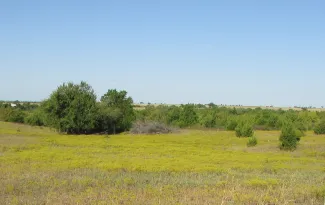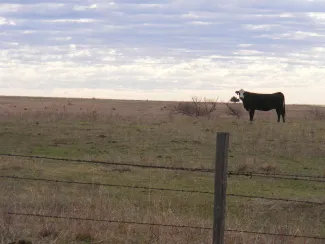Have you ever driven down a county road in mid to late summer and noticed a pasture covered in a carpet of small, broom-like yellow flowers? What about a pasture that has been grazed shorter than an HOA lawn is mowed? If so, you have most likely just witnessed a very overused or overgrazed pasture. Now, these are not the only indicators of an overgrazed pasture or range community, but these are often the easiest to notice. Unfortunately, by the time these effects show up the overuse has already occurred for some time. The effects begin at the soil level and can extend to your pocketbook.

Pastures and rangelands infested with sneezeweed and/or broomweed offer good indicators of heavy grazing use.
Historically, Oklahoma was an oasis for all kinds of wildlife and grazing animals, and today is the fifth largest producer of hay in the country. Oklahoma producers have the ability to graze both native rangeland ecosystems as well as introduced forage pastures. Overgrazing was a catalyst for proper science-based rangeland and pasture management dating back to the mid to late 1800s and continues to be one of the most common problems novice and experienced producers still face. This is due to the relationship between stocking rate, time of year (i.e. hot and dry vs temperate and wet), forage biodiversity, length of grazing intervals, and types of grazing animals.
A key point to understanding overgrazing is that it’s not a problem of overstocking – a function of number of head per acre – but a function of time. When a plant is not given adequate time between grazing events to rest and regrow, overgrazing can occur. Overstocking can lead to overutilization of forage, leading to overgrazing.
Signs that a rangeland or pasture is being overgrazed may include sparse vegetation, depleted plant cover leading to high amounts of bare soil, increased soil erosion and compaction, the presence of invasive or unpalatable species, poor water infiltration, and a loss of wildlife habitat. When repetitive, short grazing happens it results in a weak plant with shallow roots, reducing the forage quality and drought tolerance of the plant. As the plants become weak, unproductive areas will become larger and more prevalent, especially around water sources during drought years. While stocking rates may seem correct, when continuous grazing occurs over the entire area without proper rest and rotation, range and pastures will have areas of both over- and underutilization, once again resulting in lower forage quality.

Now, how does this affect your pocketbook? When range and pastures are overgrazed the average daily gain and body condition scores of grazing cattle fall resulting in poorer performance on the rail or at the sale. More inputs will be required from you like supplemental feed, fertilizers, herbicides, your time, and your labor, all of which eat away at your profits. This doesn’t take into account the usual loss or degradation of the habitat from overuse which can reduce the quality of the acreage for family or lease hunting.
With roughly 95% of Oklahoma being privately owned, overgrazing has the potential to be very devastating to our wildlife resources, especially for rangeland and grassland dependent species. Thankfully, landowners have several options when it comes to reaching out for advice on land management, grazing options and plans, and wildlife habitat recommendations including your local ODWC wildlife biologist, OSU Extension agent, and NRCS office.